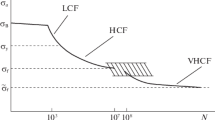Abstract
On the basis of the kinetic theory of strength, a new approach to the modeling of material degradation in cyclic loading has been suggested. Assuming that not stress changes, but acting stresses cause the damage growth in materials under fatigue conditions, we applied the kinetic theory of strength to model the material degradation. The damage growth per cycle, the effect of the loading frequency on the lifetime and on the stiffness reduction in composites were determined analytically. It has been shown that the number of cycles to failure increases almost linearly and the damage growth per cycle decreases with increasing the loading frequency.
Similar content being viewed by others
References
Case SW, Iyengar N, Reifsnider KL (1998) Life prediction tool for ceramic matrix composites at elevated temperatures. In: Bucinell RB (ed) Composite materials: fatigue and fracture, vol 7. ASTM STP 1330, pp. 165–178
Cherepanov GP (1974) Mechanics of brittle fracture. Nauka, Moscow (in Russian)
Fatemi A and Yang L (1998). Cumulative fatigue damage and life prediction theories: A survey of the stat of the art for homogeneous materials. Int J Fatigue 20(1): 9–34
Hahn HT, Turkgenc O (2000) The effect of loading parameters on fatigue of composite laminates: part IV information systems, Contract report DOT/FAA/AR-00/48
Hertzberg RW, Manson JA and Skibo M (1975). Frequency sensitivity of fatigue processes in polymeric solids. Poly Eng Sci 15(4): 252–260
Holm S and Mare J (1988). A simple model for fatigue life. IEEE Trans Reliab 37: 314–322
Holm S, Josefsson L, de Mare J, Svensson T (1995) Prediction of fatigue life based on level crossings and a state variable Fatigue Fract Eng Mater Struct 18: 1089–1100
Hsiao CC (1989) Kinetic strength of solids. In: Salama K et al (eds) Advanced research fracture: Proceedings of the 7th international conference on fracture. Pergamon, London, pp 2913–2918
Kachanov M (1987). On modeling of anisotropic damage in elastic-brittle materials: a brief review. In: Wang, ASD and Haritos, GK (eds) Damage mechanics in composites, pp 99–105. ASCE, New York
Lemaitre J (1992). A course on damage mechanics. Springer, Berlin
Lee S, Nguyen T and Chunang T (2003). Model of fatigue damage in strain-rate-sensitive composite materials. J Mater Res 18(1): 77–80
Mandell JF, Meier U (1983) Effects of stress ratio, frequency, and loading time on tensile fatigue of glass-reinforced epoxy. In: O’Brien TK (ed) Long-term behavior of composites. ASTM STP 813, American Society for Testing and Materials, Philadelphia, PA, pp 55–77
Miner MA (1945). Cumulative damage in fatigue. J Appl Mech 67: A159–A164
Mishnaevsky L (1996). Determination for the time to fracture of solids. Int J Fract 79(4): 341–350
Mishnaevsky L (1997). Methods of the theory of complex systems in modeling of fracture: a brief review. Eng Fract Mech 56(1): 47–56
Mishnaevsky L Jr (1998) Damage and fracture of heterogeneous materials, Balkema, Rotterdam, 230 pp
Mishnaevsky L Jr (2007) Computational mesomechanics of composites, Wiley and Sons
Schmauder S and Mishnaevsky L (1997). Damage evolution and heterogeneity of materials: model based on Fuzzy set theory. Eng Fract Mech 57(6): 625–636
Miyano Y, McMurray M, Enyama J and Nakada M (1994). Loading rate and temperature dependenc on flexural fatigue behavior of a satin-woven CFRP laminate. J Comp Mater 28(13): 538–550
Moskala E (1993). Effects of mean stress and frequency on fatigue crack propagation in rubber-toughened polycarbonate/copolyester blends. J Appl Poly Sci 49(1): 53–64
Narisawa I, Ishikawa M and Ogawa H (1978). Delayed yielding of polycarbonate under constant load. J Poly Sci 16(8): 1459–1470
Oh HK and Yoon WG (1995). Derivation and application of a dynamic fatigue life equation. J Mater Process Technol 49(3–4): 279–285
Oliveira FA (1998). Transition-state analysis for fracture nucleation in polymers: the Lennard-Jones chain. Phy Rev B 57: 10576–10582
Palmgren A (1924) Lebensdauer von kugellagern. Verfahreenstechinik, Berlin, 68:339–341
Paris PC, Gomez MP and Anderson WE (1961). A rational analytic theory of fatigue. Trend Eng Univ Washington 13(1): 9–14
Parsons M, Stepanov EV, Hiltner A and Baer E (2000). Effect of strain rate on stepwise fatigue and creep slow crack growth in high density polyethylene. J Mater Sci 35: 1857–1866
Phoenix SL, Beyerlein IJ (2000) Statistical strength theory for fibrous composite materials. In: Kelly A, Zweben C, Chou TW (eds) Comprehensive composite materials, vol 1. Pergamon, pp 559–639
Regel VR, Slutsker AI and Tomashevskiy IYe (1974). Kinetic nature of strength of solids. Nauka, Moscow
Reifsnider KL (1990). Composite materials series: fatigue of composites, vol 4. Elsevier, New York
Rotem A (1993). Load frequency effect on the fatigue strength of isotropic laminates. Compos Sci Technol 46: 129–138
Saff CR (1983) Effect of load frequency and lay-up on fatigue life of composites. In: O’Brien TK (ed) Long-term behavior of composites. ASTM STP 813, American Society for Testing and Materials, Philadelphia, PA, pp 78–91
Sun CT, Chan WS (1979) Frequency effect on the fatigue life of a laminated composite. Composite materials: testing and design (5th Conference), ASTM STP674, American Society for Testing and Materials, Philadelphia, PA, pp 418–430
Suresh S (1998) Fatigue of materials. Cambridge University Press, Cambridge, 704 pp
Svensson Th (1996) Fatigue life prediction in service a statistical approach, Dept of Mathematics, Gøteborg
Takemori MT (1992). Fatigue fracture of polycarbonate. Poly Eng Sci 22(15): 937–945
Wnuk MP (1974). Quasi-static extension of a tensile crack contained in viscoelastic plastic solid. J Appl Mech 41: 234–248
Yokobori T (1968). An interdisciplinary approach to fracture and strength of solids. Wolter-Noordhoff, Groningen
Yokobori T (1978). The scientific basis of strength and fracture of materials. Kiev, Naukova Dumka
Zhurkov SN (1964). Kinetic concept of the strength of solids. Int J Fract Mech 1(4): 311–323
Author information
Authors and Affiliations
Corresponding author
Rights and permissions
About this article
Cite this article
Mishnaevsky, L., Brøndsted, P. Modeling of fatigue damage evolution on the basis of the kinetic concept of strength. Int J Fract 144, 149–158 (2007). https://doi.org/10.1007/s10704-007-9086-1
Received:
Accepted:
Published:
Issue Date:
DOI: https://doi.org/10.1007/s10704-007-9086-1




